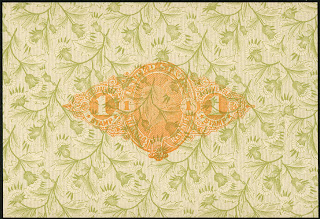
I just received another two pairs of RN X imprints on unsuitable papers, the one-cent member of one of them being pictured above. It deepened my perplexity concerning the manufacture and purpose of these "samples."
The sample books were discussed by Ernest Wilkins in the Essay-Proof Journal No. 129. He said that there were 194 pages, each of which contained an orange impression of both the one-cent and two-cent designs. He also commented on the recurring plate flaws in the copy he had at his disposal at the time. For the one-cent he listed damage to the top of the design and a spot of color in the large numeral at right. I already posted the image below, taken from another sample item on rather plain paper and showing both flaws.
In June of 2011 when I discussed these items I included the following one-cent version. It exhibits both of the flaws noted by Wilkins. It also exhibits the same wallpaper design as the one on the example at the top of this article.
The problem is that the imprint shown at top does not have the spot of color in the right numeral. None of the one-cent sample items I have acquired in the last year have it. Yet they all have the same flaw at the top of the imprint. Or is it? I've learned from close examination of several Civil War imprints that apparently identical plate flaws often are not, but products of some sort of weakness in the dies that produced flaws in the same general area.
The two-cent imprints show a similar anomaly. All of the recently acquired ones show a missing design portion at bottom, to the left of "INTERNAL." Wilkins illustrated the two-cent imprint on a sample page which he described as "floral underprint is pale green on cream color paper." This is exactly what I now have, with the damaged imprint. However, his illustration clearly shows no such damage.
The Wilkins illustration.
Damage not shown on the Wilkins illustration.
To sum up what we have so far is, first, what I will call Wilkins Samples: one-cent with frame damage and dot, two cent with no apparent damage. I have examples of these. And, second, new samples: one-cent with frame damage, no dot, two-cent with frame damage. I have five examples of these.
A deceptively simple solution is that there were at least two sample books which have been cut apart. I believe this. But - why? And what happened to the dot?
If the Bureau of Engraving and Printing, or anyone else, decided to produce these books, why only use two dies? If the printer was running several copies at a time, to be cut apart later, there were two, three, four dies being used at once. If the frame damage on the one-cent samples is not the same on the ones with and without the dot in the numeral, this is the explanation. If I could see an example where the paper is pretty clearly from a sample book but there was no frame damage on the one-cent, that would erase all doubt in my mind.
None of this addresses the other question: who produced these samples?
They are not salesman's samples. The only people who were selling the design was the Bureau, who presumably had to get approval for their design from the Commissioner of Internal Revenue. Can you imagine presenting him with a thick book of samples on things like wallpaper and foil, printed with flawed plates? I can't.
Who else could have printed them? The plates were maintained under supervision of an IRS Agent at all times, and should have been returned to the Commissioner at the termination of the contract, or when damaged or worn. It is not likely that they were abandoned at the end of the tax period, if for no other reason than that they could have been used to place imprints on checks that then could have been turned in for refund. Admittedly, after 1904 no refunds were given, so the IRS may have lost interest in the plates and some enterprising soul could have gotten hold of a set of them to run off some curiosities. The plates available at that time could have been a mix of damaged and undamaged ones, whatever was still around. This would answer all the questions except Why Bother…
I'd love to find a smoking gun, but I don't know where to look for it.


































+R175+Thompson.PNG)















